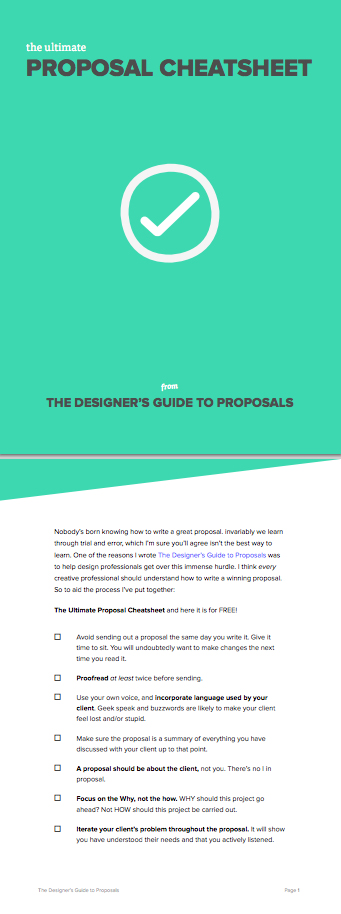The ultimate proposal cheatsheet

Nobody’s born knowing how to write a great proposal. Invariably we learn through trial and error, which I’m sure you’ll agree isn’t the best way to learn. One of the reasons I decided to publish The Designer’s Guide to Proposals free on the blog was to help design professionals get over this immense hurdle.
I think every creative professional should understand how to write a winning proposal. So to aid the process I’ve put together: The Ultimate Proposal Cheatsheet and here it is for FREE!

We've created a beautiful PDF version for you to download. That way you'll always have a reference copy nearby. **To get the sexy PDF version drop you email in the form below and we'll send it straight to your inbox. **

If you're not interested in the sexy version here's the standard online one…
The ultimate proposal cheatsheet
- Avoid sending out a proposal the same day you write it. Give it time to sit. You will undoubtedly want to make changes the next time you read it.
- Proofread at least twice before sending.
- Use your own voice, and incorporate language used by your client. Geek speak and buzzwords are likely to make your client feel lost and/or stupid.
- Make sure the proposal is a summary of everything you have discussed with your client up to that point.
- A proposal should be about the client, not you. There’s no I in proposal.
- Focus on the Why, not the how. WHY should this project go ahead? Not HOW should this project be carried out.
- Iterate your client’s problem throughout the proposal. It will show you have understood their needs and that you actively listened.
- Don’t sell yourself as a technician. You solve business problems.
- Give your client a choice with pricing. Offer several options (think SaaS).
- Price anchoring: By giving your client a basic, intermediary and premium price package, the choice becomes, "How much do I want to pay?" not "Who do I want to pay?"
- The more time you spend getting to know a client and their business, the greater your chances of closing the deal.
- Keep it simple. “Design" should only ever support the end goal. Your client should be focused on the content.
- Make sure you have all the information you need. Dig deep in those initial meetings. Ask why, a lot.
- Make it clear that by working with you your client’s business will be better off. If you can’t promise a better tomorrow why would they consider you?
- Freelancers have the unfortunate reputation of being flaky;
- a well-researched, well-written proposal will put you ahead of the game.
- Turn your initial client interview on its head. Listen, but make sure you ask the right questions. It’s up to you to learn why this project is being undertaken and what it will mean to the client should you succeed or fail.
- A proposal is not a standalone product, without a prior relationship you’ll be playing a numbers game.
- Things a proposal should address:
- This is what I know about your business.
- Here’s why the project needs to happen.
- This is my proposed solution(s), )which shows my understanding of the problem).
- Which leads into Why I’m the right person for the job.
- Tiered pricing options (or pricing of your choice).
- Added bonus for creating urgency…limited schedule etc.
- Selling a proposal to an existing client is infinitely easier than to a new one. A small sale prior to them becoming a "project" ” client can come in the form of an ebook, paid roadmapping session, discovery phase or site review. There are options…
- Tiered pricing is an opportunity to up-sell a client on services that perhaps they hadn’t previously considered.
- Reflect the client’s problem in their own words. If a client can recognize their own thoughts and language in a proposal then they’ll know you’ve understood them. This leads to We are one!
- Split your proposal into sections, people expect it. Keep each section clear and concise.
- Keep stories for your blog.
- You can include an About Us section but don’t be fooled into thinking it is about you. Focus on the client and their needs (even in the About Us).
- Focusing on yourself, your talents and technical capabilities says you haven’t spent enough time getting to know your client.
- Tackle the issue of trust and “Who am I” before getting to a proposal.
- Your tools do not define you. Solve a problem first, then use your tools to conquer that problem.
- "Where I live Branding is something that happens to cows." - Marcus Blankenship (Business Coach). Be clear and use language that your clients will understand (taken from interview in The Book and Resources pack).
- If your pricing is complicated you will lose trust. Your client will presume you’re trying to rip them off.
- Don’t cave on pricing. If a client budget falls short, reduce the scope. Dropping your price for no reason only serves to undervalue your service.
- Be prepared to walk if it’s not going to pan out. Make a recommendation for someone who can help them and say goodbye. It’s good to play suitor.
- Coming in too low can be as dangerous as going in too high. Take note; Big companies with big budgets want to spend more money. Someone with money in abundance is more likely to buy a Mercedes than a Kia.
- Writing the perfect proposal will take your client from "How can I find this cheaper?" to "What can I possibly move around to (afford) word with this person." (taken from interview in The Book and Resources pack).
- A proposal is a reinforcement of all the groundwork you’ve put in up to that point. It’s the dot on the i.
- Give your clients the option to spend more money (upsell). If you don’t give the option they won’t.
- It’s only by understanding the real motivations of your client that you can you provide a truly valuable solution.
- Not matter how many pricing options you provide, don’t let "going elsewhere" be one of them.
- Before sending out a proposal, email it to yourself. Get a feel for how it looks in your inbox and how it reads (taken from interview in The Book and Resources pack).
- If a proposal fails, follow up with the client. Ask why it didn’t work for them. It will help to avoid making similar mistakes in the future.
- Nothing is set in stone. Experiment with everything!